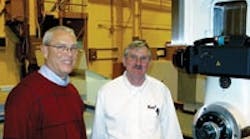"Multi-tasking decisions ultimately depend on doing a real analysis of the number of parts to be processed, the kinds of operations to be done and whether it makes sense to tie up several machines doing individual tasks or a more complex machine to do all the tasks required." That's how to begin thinking about analyzing, justifying and maximizing a multi-tasking investment, says Rich Curless, chief technical officer, MAG Industrial Automation Systems. He says your conclusion will also depend on volume, part features, size of the part, required quality and the business case your company wants to go after.
Also factor in the typical life of the product the parts are destined for, he adds. Your analysis will likely be different for products like earth-moving equipment with a 10-year lifecycle than for auto parts that might usually last only three or four years.
"Typically," says Curless, "in making parts for long life products like earth-moving equipment, multi-tasking could easily be justified. The approach gets everything done in one setup. But with the high-volume automotive parts, it's easier to justify more setups and more machines."
His point: Don't forget to factor in the capital equipment expense with the business case analysis. Typically, he notes, a multi-tasking machine is going to have a higher initial investment than a single purpose machine.
So the analysis must contrast the capability of the multi-tasking equipment with the projected needs of the business model including the capital expense, Curless says. For example, consider how changing to a new family of parts might affect the various equipment alternatives. With a single-purpose machine tool, you may find that type of change easier to make than on a more complex multi-tasking machine tool. And to get the full potential of multi-tasking equipment, operator and programmer training may be needed to accommodate the new processes. For example, work synchronization becomes a machine issue and you have to make sure that the programmer has some knowledge of all of the machine's functions.
Maximizing the justification decision requires a close match between the multi-tasking equipment's potential and the part making model, adds Ken Campshure, director of sales, MAG Giddings & Lewis. Enthusiasm for the mill-tasking capabilities of a machine tool is not adequate validation, he says. Multi-tasking is a great tool, but it ultimately has to be analyzed in light of the user's environment.
Things to consider include the plant's sophistication: Does the shop have the skill sets? Is the volume there to support multi-tasking? Do the tolerance requirements merit multi-tasking?
Campshure notes that already installed equipment can be a factor. "Consider the job shop that has four horizontal boring machines and one turning machine," he says. "As a result it has all kinds of milling and boring capability, but only limited turning. So to buy a mill-turn machine with four boring mills sitting there may not make any sense. Maybe the shop should invest in a dedicated turning machine to add to capacity and balance the load. On the other hand if the shop has milling and turning equally balanced today and an opportunity with relatively high volume comes in, then the mill-turn may make a lot of sense."
Factors to consider in favor of multi-tasking also include such things as big and heavy parts, emphasizes Campshure. "Being able to reduce part handling builds a strong case for multi-tasking. By eliminating multiple part handling, a multi-tasking system will offer more throughput than a dedicated machine."
See Also




